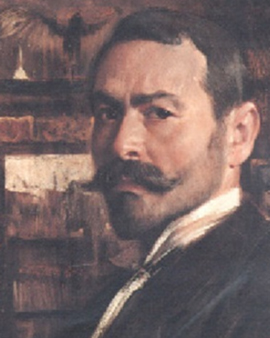


Adolf Hirémy-Hirschl, born Adolf Hirschl on January 31, 1860 in Timisoara in the Empire of Austria and died in 1933 in Rome in the Kingdom of Italy, was a painter of Hungarian origin. His intricate and powerful paintings, displayed in high-quality fine art prints, capture the dramatic flair of history and antiquity, with his style influenced by classical, academic painting. Hirémy-Hirschl's childhood was dominated by art, having moved to Vienna at a young age. There he graduated from the prestigious Academy of Fine Arts from 1874 to 1882, and his skills were recognized by a scholarship that enabled him to travel to Egypt and visit Rome for the first time. These experiences colored his art and led him on a path crowned by numerous awards, including the Kaiser Prize and the Great Golden State Medal.
The 1890s were exciting for Hirémy-Hirschl both professionally and personally. An affair with a married woman, Isabella Henriette Victoria Ruston, ignited a scandal that shook Viennese society. The scandal eventually led to Isabella's divorce and her subsequent marriage to Hirschl. The couple had a daughter named Maud. Deeply hurt by the social reaction, Hirschl resumed his Hungarian citizenship and changed his name to Hirémy-Hirschl. He left Vienna and settled in Rome, where he participated in the exhibitions of the Amatori e Cultori di Belle Arti in the following years. As a history painter, Hirémy-Hirschl remained true to his academic painting style despite his friendship with Gustav Klimt before the founding of the Secession. He often created large-scale history paintings in the style of Karl Theodor von Piloty that depicted ancient myths and history, such as "Hannibal's March Across the Alps," "Invasion of Rome by the Vandals," or "The Plague in Rome." These works enjoyed great popularity at the turn of the century and their reproduced art prints still attract admirers today. In addition to his historical paintings, he also created Mediterranean landscapes and portraits depicting sun-drenched Italy. His art continues to stay alive thanks to exquisite art prints that reproduce his works and fascinate art lovers worldwide. Each Adolf Hirémy-Hirschl art print tells a story, a tribute to the Hungarian master whose talent and dedication to art remains unforgotten.

Adolf Hirémy-Hirschl, born Adolf Hirschl on January 31, 1860 in Timisoara in the Empire of Austria and died in 1933 in Rome in the Kingdom of Italy, was a painter of Hungarian origin. His intricate and powerful paintings, displayed in high-quality fine art prints, capture the dramatic flair of history and antiquity, with his style influenced by classical, academic painting. Hirémy-Hirschl's childhood was dominated by art, having moved to Vienna at a young age. There he graduated from the prestigious Academy of Fine Arts from 1874 to 1882, and his skills were recognized by a scholarship that enabled him to travel to Egypt and visit Rome for the first time. These experiences colored his art and led him on a path crowned by numerous awards, including the Kaiser Prize and the Great Golden State Medal.
The 1890s were exciting for Hirémy-Hirschl both professionally and personally. An affair with a married woman, Isabella Henriette Victoria Ruston, ignited a scandal that shook Viennese society. The scandal eventually led to Isabella's divorce and her subsequent marriage to Hirschl. The couple had a daughter named Maud. Deeply hurt by the social reaction, Hirschl resumed his Hungarian citizenship and changed his name to Hirémy-Hirschl. He left Vienna and settled in Rome, where he participated in the exhibitions of the Amatori e Cultori di Belle Arti in the following years. As a history painter, Hirémy-Hirschl remained true to his academic painting style despite his friendship with Gustav Klimt before the founding of the Secession. He often created large-scale history paintings in the style of Karl Theodor von Piloty that depicted ancient myths and history, such as "Hannibal's March Across the Alps," "Invasion of Rome by the Vandals," or "The Plague in Rome." These works enjoyed great popularity at the turn of the century and their reproduced art prints still attract admirers today. In addition to his historical paintings, he also created Mediterranean landscapes and portraits depicting sun-drenched Italy. His art continues to stay alive thanks to exquisite art prints that reproduce his works and fascinate art lovers worldwide. Each Adolf Hirémy-Hirschl art print tells a story, a tribute to the Hungarian master whose talent and dedication to art remains unforgotten.
Page 1 / 1






